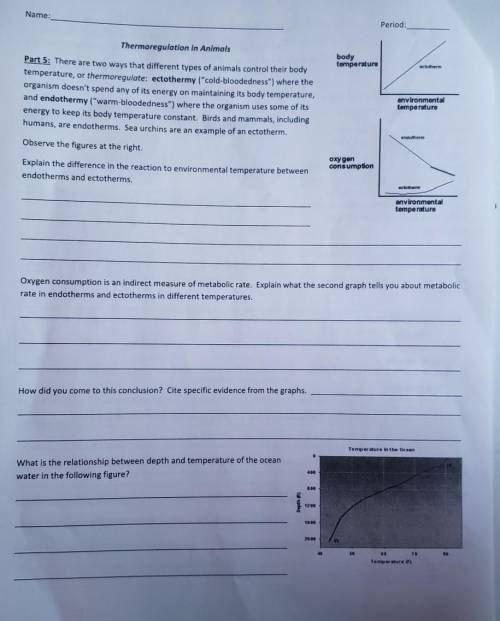
Biology, 03.12.2021 17:00 zachcochran2007
Thermoregulation in Animals Part 5: There are two ways that different types of animals control their body temperature, or thermoregulate: ectothermy ("cold bloodedness") where the organism doesn't spend any of its energy on maintaining its body temperature, and endothermy ("warm-bloodedness") where the organism uses some of its energy to keep its body temperature constant. Birds and mammals, including humans, are endotherms. Sea urchins are an example of an ectotherm. Observe the figures at the right. Explain the difference in the reaction to environmental temperature between endotherms and ectotherms.


Answers: 1


Another question on Biology

Biology, 22.06.2019 14:20
When a population split into two subgroups what is most likely to cause the subgroups to develop different traits?
Answers: 1

Biology, 22.06.2019 17:00
Which of the following is one way in which organisms such as clown fish and sea turtles are able to overcome the many dangers that their offspring encounter and ensure that their species population numbers stay relatively steady
Answers: 1

Biology, 22.06.2019 19:30
On a backpacking trip, kenny hikes all day at a steady pace, covering 30 kilometers and burning 4000 calories. at the school track, janelle runs the 100-meter sprint in 13.5 seconds, burning 10 calories. afterward, janelle’s leg muscles are aching and she is breathing hard, while kenny maintains normal breathing all day, even though he burns 400 times more calories than janelle. which two statements offer the best explanation for this phenomenon? a. if the aerobic pathway—cellular respiration—cannot meet the energy demand, then the anaerobic pathway—lactic acid fermentation—starts up, resulting in lactic acid buildup and "oxygen debt." b. aerobic cellular respiration produces more energy, but its use is limited because of lactic acid buildup in the muscles and the resulting "oxygen debt." c. after about 90 seconds of intense exercise, the muscles become depleted of oxygen, and anaerobic respiration can no longer function to produce atp, resulting in "oxygen debt." d. the rate of energy demand determines how the muscles will obtain energy, either from cellular respiration or from lactic acid fermentation if not enough oxygen is present.
Answers: 3

Biology, 22.06.2019 21:30
Which of the following is true about the introduction of a non-native species to an environment? (a) they usually adapt quickly so they can have a positive affect on the environment. (b) they can disrupt the environment and cause much damage and devastation to native species. (c) they usually become predators in a food chain and to keep prey populations under control. (d) because the native species are better-adapted to the environment, the non-native species always end up dying out.
Answers: 1
You know the right answer?
Thermoregulation in Animals Part 5: There are two ways that different types of animals control their...
Questions




Computers and Technology, 21.05.2020 19:10

Advanced Placement (AP), 21.05.2020 19:10


Mathematics, 21.05.2020 19:10

Health, 21.05.2020 19:10

History, 21.05.2020 19:10

Mathematics, 21.05.2020 19:10

Physics, 21.05.2020 19:10

Law, 21.05.2020 19:10

Mathematics, 21.05.2020 19:10

Geography, 21.05.2020 19:10




Social Studies, 21.05.2020 19:10

Mathematics, 21.05.2020 19:10

Mathematics, 21.05.2020 19:10



